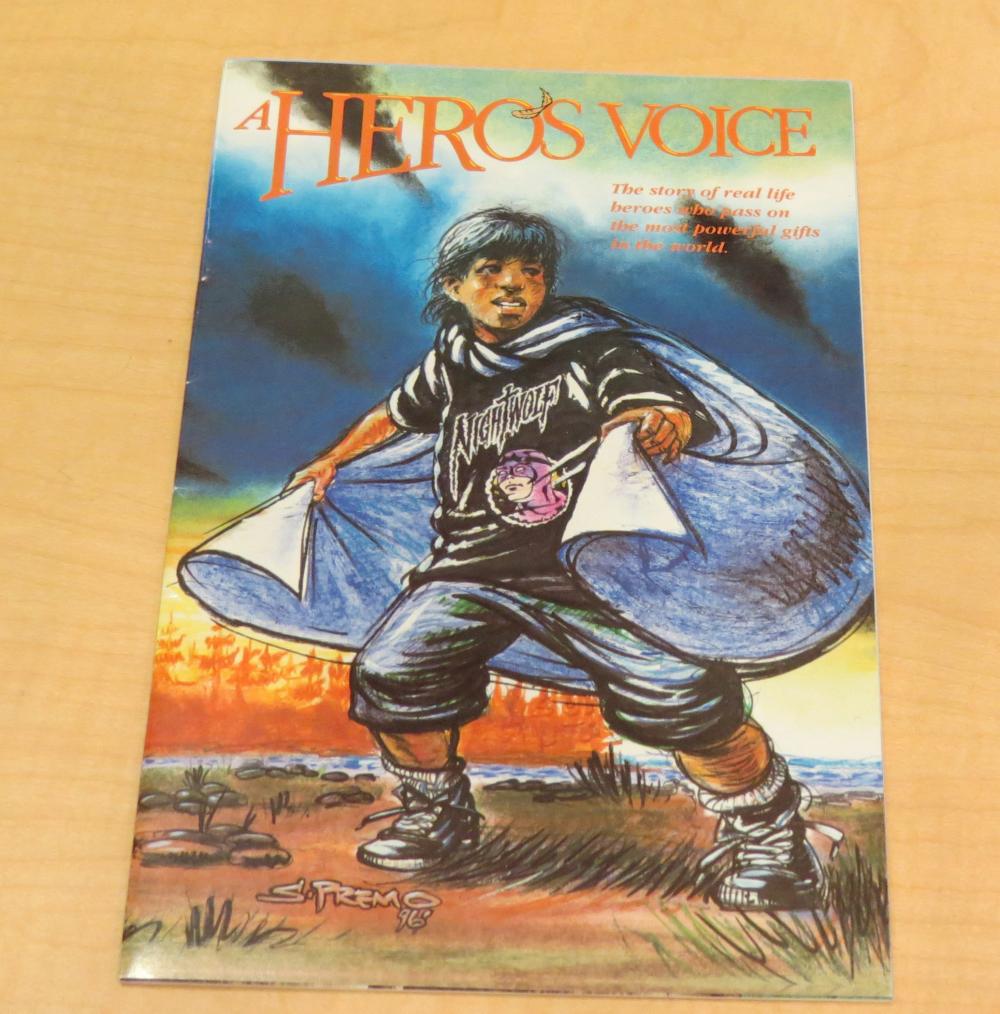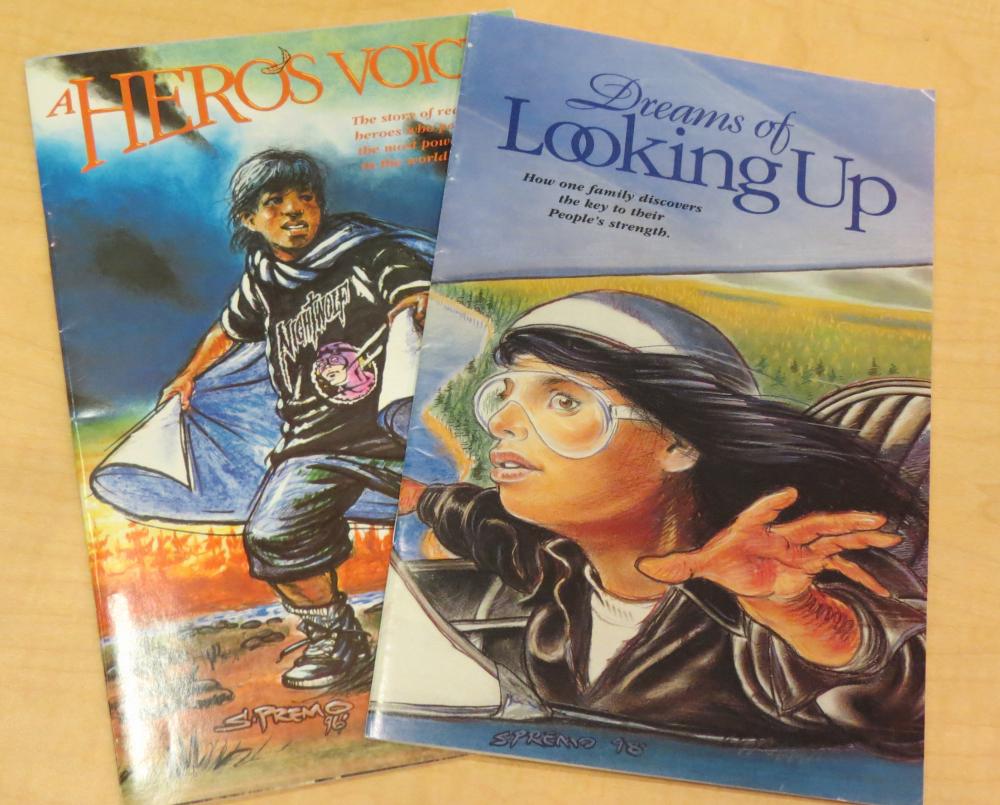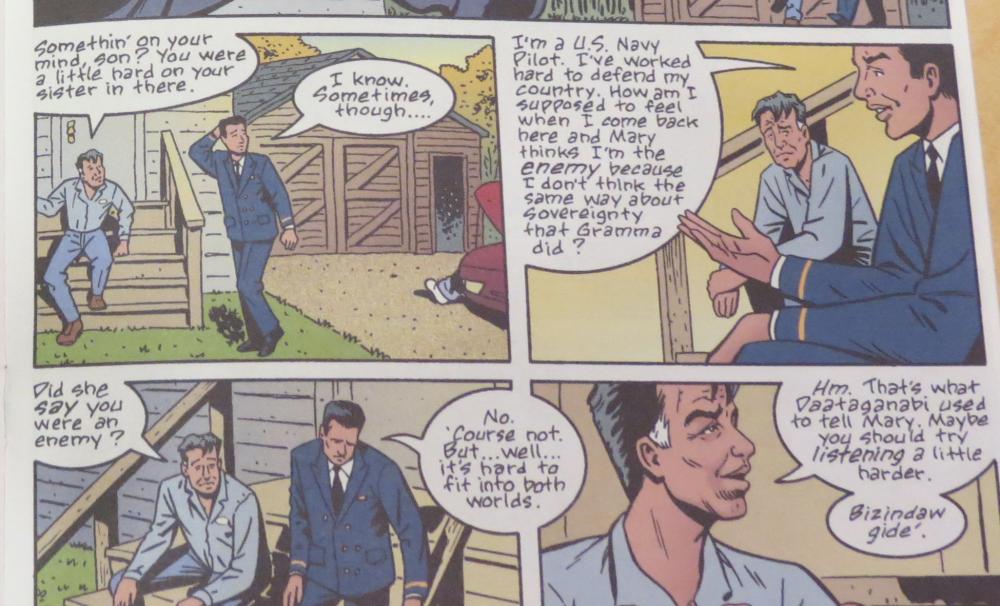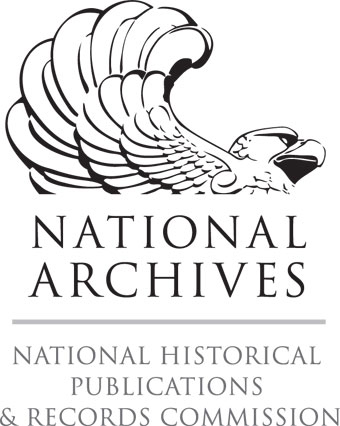
A young boy posed in a wide stance gazes into the distance. His arms hold a cape outstretched at his sides. The young boy’s name is Georgie and he is an Ojibwe of the Mille Lacs Band in Minnesota. Georgie is one of the many characters depicted in comic books produced by the Mille Lacs Band to educate their children, and also the non-Native American public, on Ojibwe culture. In the comic A Hero’s Voice, Georgie’s grandfather teaches him the importance of recognizing the real heroes in his life, his ancestors, not imagined comic book heroes. Georgie’s grandfather guides him through hundreds of years of Ojibwe history, highlighting how his ancestors fought to protect their rights and land from Anglo interlopers. At the end of the story Georgie is told that he too can be a hero, by protecting the culture of his people, making sure their stories are not erased and that their sovereignty is protected.
These Mille Lacs Band comic books are available through UNLV University Libraries Special Collections in the Katherine A. Spilde Papers on Native American Gaming. The comics are illustrated in a typical comic book style and are both a form of entertainment and an educational tool. While the graphics of the comic book style keep the content approachable, the issues addressed within are serious problems that Native Americans have faced in the past and face in the present. The issues include broken treaties with the United States government, illegal encroachment on Native American lands, and forced assimilation into Anglo culture. Stressing the cultural heritage of the Mille Lacs Band, the characters throughout the comic speak in both English and Ojibwe. At the end of the comic is a reference guide, available to teach those who do not speak Ojibwe what the words mean, encouraging the learning of the language. Language revival is both a form of cultural and political sovereignty.

A Hero’s Voice, illustrated by Mille Lacs Band member Steve Premo and by Paul Fricke; written by Steve Premo and Cindy Goff. Dreams of Looking Up, illustrated by Mille Lacs Band member Steve Premo and by Paul Fricke; written by Cindy Goff. (Comics published in 1998 by the Mille Lacs Band of Ojibwe.)
In the comic, Dreams of Looking Up, Mary a young Mille Lacs Band teenager feels compelled to confront her brothers about the importance of actively remembering their culture and the need to protect their traditions from erasure. The comic also grapples with the issue of assimilation. Mary’s eldest brother, Junior, feels conflicted about where he fits into Mille Lacs society given he recently joined the United States Navy. He struggles with the question of whether or not he can be part of both worlds. Through the advice of his sister, provided to her by the spirit of her grandmother, she explains how Ojibwe can be part of their traditional culture and part of American society as well.
The Mille Lacs Band comic series is unique because it addresses particular issues faced by Native American children, which are not addressed by mainstream comics. The comics help guide youths that are wrestling with their cultural identity, showing how young Ojibwe people can participate in mainstream culture while maintaining their Ojibwe cultural roots. These issues are not only unique to Native American children and the discussion of identity is a subject many non-white children can relate to. I felt personally connected to Junior’s struggle to contemplate how he could be part of two worlds. As a person of mixed race, I often struggle to find a balance between the two cultures I represent. Like Junior, I often contemplate if I can be part of two cultures equally, without turning away from or identifying with one culture more than the other; furthermore, I wonder what the implications of leaning more toward one or the other might mean for me. While Junior’s struggle is specifically about maintaining a connection to his Native American culture and being a part of the United States military, this feeling of cultural tension is a struggle relatable to many multiracial people and makes the Mille Lacs Band comics relevant to a larger audience.

Detail from Dreams of Looking Up by Premo, Fricke, and Goff (1998)

In addition to discussions of identity, the Mille Lacs Band comic series represents Native Americans in a medium where most heroes are white males. The comics reference many Native American leaders throughout history who have worked to protect Native American sovereignty such as Shawbashkung and Arthur Gahbow. The comics offer an authentic perspective written by Native Americans. Masterfully using the comic book genre as a tool for educational and cultural heritage, the comic books successfully blend cultural and political sovereignty into informative and approachable representations of Native American identity.
These Mille Lacs Band comic books are just two of many interesting items in the Katherine A. Spilde Papers on Native American Gaming (MS-00092) that document twentieth-century Native American culture. Hana Gutierrez is an undergraduate student in psychology at UNLV who is working on a National Historical Publications and Records Commission-funded project to process and organize the Spilde papers; this project aims to preserve, make accessible, and increase the visibility of these historical materials.


